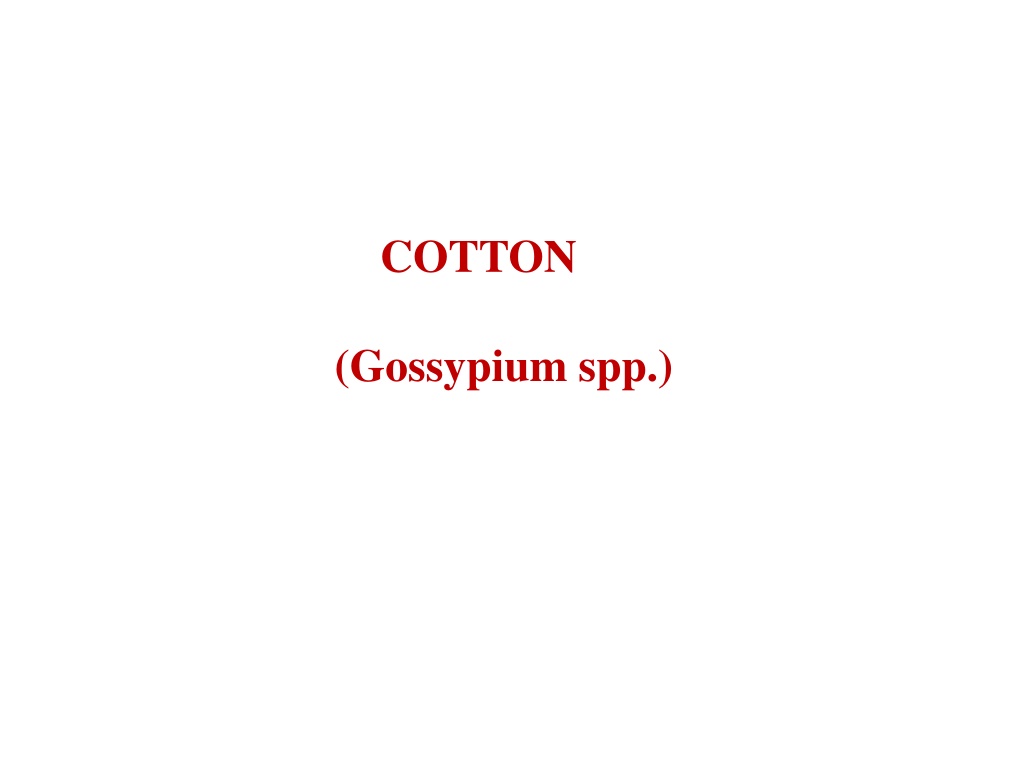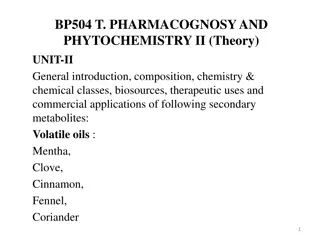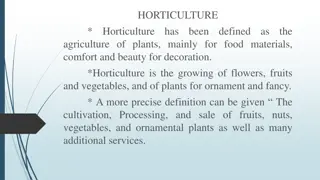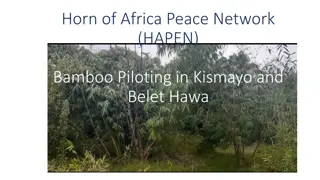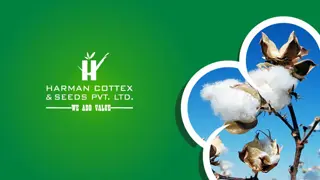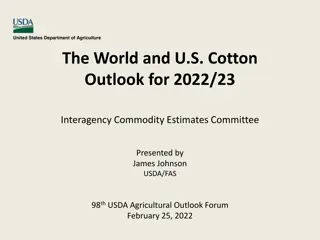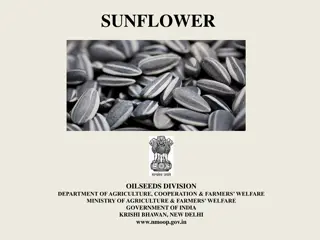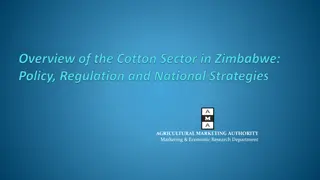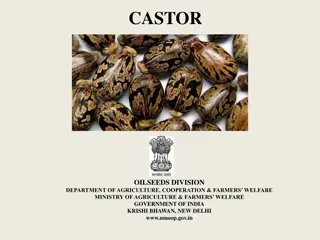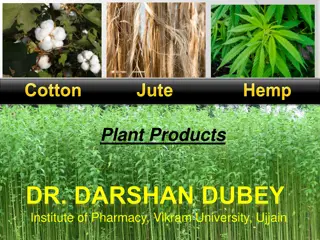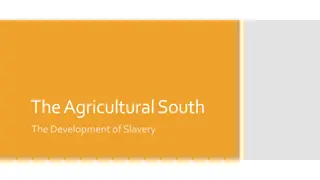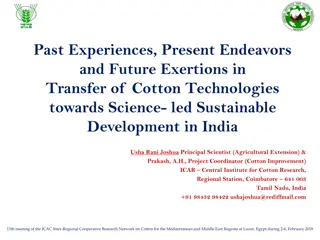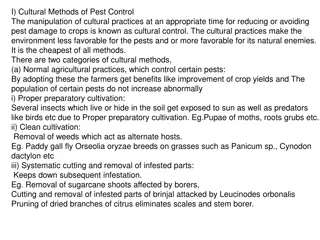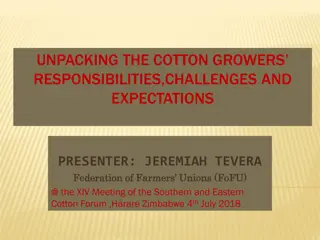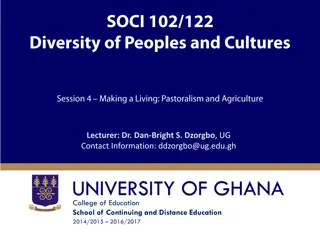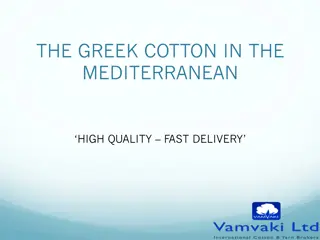The Importance of Cotton Cultivation in Commercial Agriculture
Cotton, a crucial commercial crop globally, plays a significant role in the economic, political, and social aspects of various countries. Cultivated in tropical and subtropical regions, cotton requires specific climatic conditions for successful growth and yield. The crop season varies across different regions, with variations in soil requirements, sowing seasons, and cultivation practices. With India leading in cotton production and cultivation, the diverse aspects of cotton farming underscore its importance in the textile industry.
Uploaded on Sep 19, 2024 | 0 Views
Download Presentation

Please find below an Image/Link to download the presentation.
The content on the website is provided AS IS for your information and personal use only. It may not be sold, licensed, or shared on other websites without obtaining consent from the author. Download presentation by click this link. If you encounter any issues during the download, it is possible that the publisher has removed the file from their server.
E N D
Presentation Transcript
COTTON (Gossypium spp.)
Cotton is the most important commercial crop of the world, supplying clothing to the mankind. The cotton fibres are the raw material required to produce yarn (procees called spinning), which is used to weave the cloth (process called weaving).
Cotton, white gold, one of the most important commercial crops, play a key role in economic, political and social affairs of the world. It is cultivated about 60 countries of the world and 10 countries, viz the USA, former USSR, China, India, Brazil, Pakistan, Turkey, Mexico, Egypt and Sudan, account for nearly 85% of the total production. With nearly 8.97 million ha under cotton crop, India ranks first in the world in area and third in total production which reached the level of 232 lakh bales during 2004-2005. India is the only country in the world where all the 4 cultivated species of cotton
Climate and soils Cotton, a semi-xerophytes is grown in tropical and subtropical conditions. For the successful germination of its seeds, a minimum temperature of 150C is required. The optimum temperature for vegetative growth is 21-270C. It can tolerate temperature as high as 430C but does not do well, if it falls below 210C. During period of fruiting, warm days and cool nights with large diurnal variations are conducive to good boll and fibre development. In rainfed cotton, which predominates and occupies 65% of the area, a minimum rainfall of 50 cm is required. More than actual rainfall, the favourable distribution, is the deciding factor in obtaining good yields from rainfed cotton.
Soil requirement Cotton is grown on a variety of soils, ranking from well- drained deep alluvial soils in the north to black clayey soils of varying depth in Central Zone and the black and mixed black and red soils in South Zone. Cotton is moderately-tolerant to salinity and is sensitive to water logging, and thus prefers well-drained soils.
Crop season Its sowing season varies considerably from tract to tract and is generally early (April-May) in northern India, and is monsoon-based as one goes down the south. The irrigated-crop is sown in March-May and rainfed crop in June-July with commencement of monsoon. The pre-monsoon dry sowings practised in parts of Maharashtra, Gujarat and Madhya Pradesh in the end of May or in early June, have been found to give an early start, with the resultant increased yields. In Tamil Nadu, the major portion of the irrigated and rainfed crop is planted in August-October, whereas for rainfed crops in Southern districts, the sowing is extended up to November. In parts of Karnataka and Andhra Pradesh, G. herbaceum is usually sown in August-September. Early sowing done in the Dharwad-Gadag area in the beginning of July has been found to give better yields. In addition, summer sowing in Tamil Nadu and some parts of Karnataka is done during February-March. The sowing of cotton in the rice fallows of Andhra Pradesh and Tamil Nadu extends from the second half of December to middle of January.
Land preparation The time available for land preparation following harvest of wheat is limited in the North Zone. Pre-sowing irrigation irrigation is undertaken after the harvest of wheat. The land is worked upon with tractor drawn implements and levelled and planked before preparing ridges upon which sowing is done. In central and South Zones, where cotton is a rainfed crop, deep ploughing is recommended to destroy perennial weeds once in 4-5 years. The field is prepared by repeated ploughing and harrowing with the onset of pre-monsoon rains. Crop is recommended to sow on ridges and furrows in drylands for moisture conservation and weed management. In the red soils of South Zone, having poor retention , field is given 2-3 harrowing followed by shallow ploughing and sowing is done on ridges. The availability of herbicides for weed management has opened up options for reduced tillage and residue management, which are more energy efficient and have an ameliorative effect on soil quality.
Method and sowing time Cotton is sown using tractor or bullock drawn seed drill or by dibbling. Hand dibbling of seeds at recommended spacings is commonly practised in rainfed areas, particularly for hybrids. This system ensures proper plant stand and uniform geometry and also save the seeds. The crop is thinned to retain recommended population. The sowing time varies considerably in different cotton growing zones. The seed rate, spacing and plant population of different varieties varies in different regions. The plant population and geometry vary with plant architecture, soil fertility status, soil moisture holding capacity and species of hybrid cotton. Closer spacing is recommended for dwarf, compact, and short duration varieties. By improving leaf area index with closer spacing, it is found to be advantageous for higher seed-cotton yield. Higher seed rate is used in North Zone to counter seedling mortality in May because of heat. Spot application of compost FYM @ 5 tonnes/ha reduces heat related seedling mortality. In other zones thinning is effected to retain 1-2 plants/hill.
Nutrient management Climatic factors- rainfall and temperature; soil factors- soil type, depth, pH, EC, CaCO3 content and organic matter, and crop factors like genotype and duration, determine nutrient requirement of cotton. Organic manure is added once in 2-3 years in central and Southern zones, but this is seldom practised in Northern zone. Integrated nutrient management including chemical fertilizers supplanted by farm wastes, crop residues and biofertilizers as well as green manure is recommended in all zones.
Post cultivation practices and weed control The thinning of cotton crop is a special feature of irrigated crop sown on ridges in peninsular India and parts of Gujarat. Thinning is desirable for maintaining optimum plant population to obtain high yield. In irrigated row sown crop and under weed control intercultivation is done regularly with blade harrow. In the broadcast sown crop 1 or 2 hand hoeing are given to remove weeds. Cotton yields are reduced by 50-85% with unchecked weed growth or their ineffective weed control. Fluochloralin @ 1 kg a.i /ha or Pendimethalin @1 kg a.i /ha as preplant incorporation with 1 hand weeding and cross wise hoeing is useful for satisfactory weed control up to 45 days.
Water management: Depending upon the climate and crop growing period, cotton needs 700-1200 mm water to meet its maximum water requirement. The water requirement is low during 60-70 days after sowing and highest during flowering and boll development. Irrigation schedule Cotton is commonly flood irrigated although irrigation by furrow or alternate furrow method is more efficient in water saving. Drip irrigation is becoming popular, particularly for hybrids in Central and South zones. Cotton needs to be irrigated at 50-70% depletion of available soil moisture. Based on the climatologically criterion of scheduling, irrigation at 0.6 IW: CPE with 6 cm depth is common. On sandy loam soils of North Zone, 3-5 irrigations are commonly given. On the red sandy loam soil of Tamil Nadu with low water retention capacity, 4-13 irrigations may be necessary.
Harvesting and yield In the USA and former USSR, cotton is picked with suitable machines, since holdings are very large and labour is scarce. In India cotton is picked with suitable machines. The crop cannot be harvested at one stretch the picking of opened balls is carried out at suitable intervals covering picking season of several weeks. Well opened and dried bolls alone are to be picked otherwise quality of the fibre will not be good. Yield varies widely from tract to tract and from season to season depending upon agroclimatic conditions. The yield per unit area of cotton in India increased from 90 kg lint/ha during 1947-48 to 440 kg lint/ha during 2004-05.
Classification Based on ploidy and origin: Throughout the world, four species of cotton are grown. They are Indian /Asiatic/old world/Desi cotton 1.Gossypium arborium (2n=26) diploid species 2.Gossypium herbaceum (2n=26) diploid species American cotton/ new world cotton 1. Gossypium hirsutum (2n= 52) tetraploid species 2. Gossypium barbadense (2n= 52) tetraploid species
Based on hybridization 1. Interspecific hybrid Interspecific hybrid: there is no possible cross between desi and American cotton. Hybrid between G. Hirsutum and G. Barbadense or G. Herbaceum and G. arboreum 2. Intraspecific hybrid Hybrid between two varieties of G. hirsutum species (popularly called intra hirsutum hybrids) or two varieties of G. arboreum species. Barbadense is not suitable for Indian condition due to pest and diseases. Hence intraspecific hybrid is not possible in barbadense
Based on fibre length: Super long staple cotton:more than 27 mm Long staple cotton: between 24.5 to 26.9 mm Super medium staple cotton: between 22.0 to 24.4 mm Medium staple cotton: 20 to 21.9 mm Short staple cotton : less than 19.9 mm Length of fibre will decide the q1uality of fibre because in process of making yarns, longer the fibre better is the yarn and better finishing products. In India there is demand for staple cotton. Though production of desi cotton is less, we still grow because there is response for demand for short staple cotton in world market
Difference between different species of cotton Character Arborium Herbaceum Hirsutum Barbadense Hairiness Pubiscent Glaborous Young leaves Young leaves pubiscent pubiscent Leaf lobes 5-7 ovate 3-7 ovate 3-5 triangular 5-7 deep cut ovate Monopodials Less,weak Nil 2-3/plant 3-5/plant Sympodials Less ( 8-10) 4-5 12-15 14-16 Capsules Pitted and Smooth round Few pits and Highly pitted and oblong tapering flattened Seeds Thin fuzz Thick fuzz Thin fuzz Fuzzless Fibres Short to medium short Long-medium Long-extra long Pest and Resistant Highly Suseptable to Highly prone to pest and disease resistant insects diseases under irrigated condition Spacing 1 0.5 feet 1 0.5 feet 2 2 feet/ 3 2 feet 3 2 feet /3 3 feet/4 2feet
Cotton growing regions of country Southern hirsutum herbaceous belt Northern hirsutum arboreum belt Western arboretum herbaceum belt No large scale cotton area under eastern part of country. Cultivation of cotton Deep ploughing, mainly grown in kharif. Spacing for hybrids (H B): 4 2 ft, 3 3 ft and 3 2 ft H A: 2 2 ft and 3 2 ft Irrigation : cotton is not compulsorily irrigated. Water requirement is 60-65 cm. Duration: Herbaceum: 220 days, H B: 190 days , H A: 170 days Varieties: 150-220 days, Hybrids: 150-195 days Herbicides: Diuron, Pendimethalin, Alachlor
Fertilizers Hybrids: 150:75:75/ha Varieties: 100:60:40/ha, 50:50:40/ha
Bt-Cotton: It is a soil borne bacteria. It is known to release specific protein which are poisonous to pest. This protein is called CRY proteins. These protein will kill boll worms. Gene responsible for production of CRY protein in Bt bacteria is transfer to cotton successfully called as Bt.Cotton. these are also called as transgenic cotton. Advantages of Bt cotton: Increasing the cotton yield by reducing the damages to the cotton bolls. Reducing the cost of production, as cost of repeated chemical spray is avoided. Environmental protection, as cost of repeated chemical spray is avoided. The crop duration in many Bt hybrids is reduced by 10-12 days. Limitations of Bt cotton: Bt cotton are not resistant to all the pests of cotton. Hence, BT cotton will need sprays to control the leaf sucking, and shoot boring insects. Bt cotton seeds are very costly than conventional seeds of cotton. Repeated use of Bt variety/hybrid has not given consistant results in protecting the crop against pests. Over years, insects may get immune to endotoxin.
Coloured cotton: Novel fancy type of research. It is fundamentally based on the colour of fibre. Gossypium therburi have coloured lint and fibre. Organic cotton: Throughout India 50% of pesticide is consumed by cotton itself. Thus organic cotton helps in controlling the ecosystem by pesticide pollution. Varieties: Hirsutum: Sharadha, LRA 5166, Abadhita Herbaceum: Jayadhaa Arborium: Srisailam.AKH-4 Barbadense: Suvin H B:Varalaxmi H H: Savitha
Quality of cotton Seven to eight days after pollination. Most of the varieties complete the growth if the length of fibre. Length is predecided by genetic character. Cotton fibre is hollow tube made of cellulose and length is decided first five days. Later photosynthesis takes place and converted into cellulose and gets accumulated inside tube in form of rings. Fully matured fibre will have very small lumen. As fibre develops more and more cellulose deposited. Length of fibre depends on 1. Length factor 2. Extend of cellulose deposition in fibre Maturity co-efficient index = M+0.6 H+0.4 I/100 It varies from 0.6-0.8 M: Mature fibres H: Half mature fibres I: immature fibres
Fibre fineness: It is found out by instrument micronaire. Halo length: A rough estimate of fibre length, assessed without fibres being separated fron the seed. Tenacity: It is the indicator of strength of the fibre Ginning out turn (GOT) /Ginning percent: It varies from 35-40%. Lint weight/cotton weight 100 Count: Number of hanks of 840 yards which weigh one lb Stelometer: It is used to test tenacity. Lint index: Weight of lint of 100 seed cotton Acid delinting: Removal of all the fibres on cotton by treatment of seeds with 5% hydrochloric acid for half an hour, washing them with cold water and drying them in shade. Seed index: 100 seed weight
Lint: Mass of fibres separated from the seeds in a given sample of cotton. Yarn: A thread prepared by spinning many fibres together, so that they are held end to end, which offer strength to the yarn. It is a basic materiual to wave a cloth. Ginning: Process of separating the fibre from cotton seed by specialized machines. Spinning: Rotating a tuft of fibres from one end to produce yarn. Square: A floral bud of cotton with three sepals covering a bud in a triangular way. Emasculation: Removal of male parts from a flower, so that pistil receives plooen from external source, mainly adopted to avoid self-polination. Crossing: An emasculated flower is dusted artificially with pollen from a desired parent, so that the receptive stigma of emasculated flower is fertilized from a desired parent. Bale: A packing of cotton or lint appox. 170 kg in loosely knit bag using Deccan hemp or any strong fibre. Lint bales are machine pressed, while cotton bales are manually pressed.
Leaf reddening in cotton: It is a physiological problem in H B hybrid cotton. It is manifested by leaf lamina tunring reddish /pinkish red from margin toward midrib without any curling or crimping of surface. This is caused by reduced chlorophyll content resulting in loss of proportion between chloropyhyll and anthocyanin pigments in leaf. The chlorophyll is lost by the reduced supply of nitrogen due to lesser N supply or due to reduced N translocation. It can be corrected by spraying 2% urea or 2% DAP or 50 ppm gibberellic acid. Often leaves turn red due to other reasons such as moisture stress, or excess moisture or even attack by leaf sucking insects. But such redding will not turn entire leaf into red and often associated with crimpage or curling of leaf lamina.
